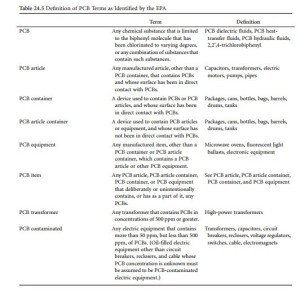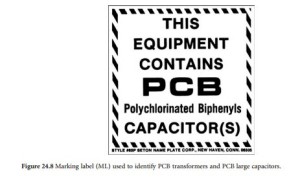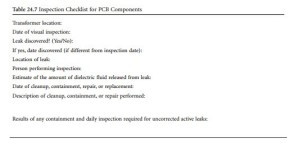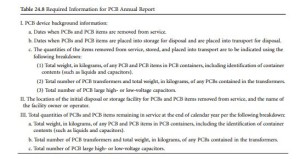Polychlorinated Biphenyls
Polychlorinated biphenyls (PCBs) belong to a family of organic compounds known as chlorinated hydro- carbons. Virtually all PCBs in existence today have been synthetically manufactured. PCBs are of a heavy, oil-like consistency and have a high boiling point, a high degree of chemical stability, low flammability, and low electrical conductivity. These characteristics led to the past widespread use of PCBs in high-volt- age capacitors and transformers. Commercial products containing PCBs were distributed widely from 1957 to 1977 under several trade names, including:
• Aroclor
• Pyroclor
• Sanotherm
• Pyranol
• Askarel
Askarel also is a generic name used for nonflammable dielectric fluids containing PCBs. Table 24.4 lists some common trade names for Askarel. These trade names typically are listed on the nameplate of a PCB transformer or capacitor.
Health Risk
PCBs are harmful because, once they are released into the environment, they tend not to break apart into other substances. Instead, PCBs persist, taking several decades to slowly decompose. By remaining in the environment, they can be taken up and stored in the fatty tissues of all organisms, from which they are released slowly into the bloodstream. Therefore, because of the storage in fat, the concentration of PCBs in body tissues can increase with time, even though PCB exposure levels may be quite low. This process is
called bioaccumulation. Furthermore, as PCBs accumulate in the tissues of simple organisms, which are consumed by progressively higher organisms, the concentration increases. This process is referred to as biomagnification. These two factors are especially significant because PCBs are harmful even at low levels. Specifically, PCBs have been shown to cause chronic (long-term) toxic effects in some species of animals and aquatic life. Well-documented tests on laboratory animals show that various levels of PCBs can cause reproductive effects, gastric disorders, skin lesions, and cancerous tumors.
PCBs can enter the body through the lungs, the gastrointestinal tract, and the skin. After absorption, PCBs are circulated in the blood throughout the body and stored in fatty tissues and skin, as well as in a variety of organs, including the liver, kidneys, lungs, adrenal glands, brain, and heart.
The health risk lies not only in the PCB itself, but also in the chemicals developed when PCBs are heated. Laboratory studies have confirmed that PCB by-products, including polychlorinated dibenzo- furans (PCDFs) and polychlorinated dibenzo-p-dioxins (PCDDs), are formed when PCBs or chloroben- zenes are heated to temperatures ranging from approximately 900 to 1300°F. Unfortunately, these products are more toxic than PCBs themselves.
Governmental Action
The U.S. Congress took action to control PCBs in October 1975, by passing the Toxic Substances Control Act (TSCA). A section of this law specifically directed the EPA to regulate PCBs. Three years later, the EPA issued regulations to implement a congressional ban on the manufacture, processing, distribution, and disposal of PCBs. Since that time, several revisions and updates have been issued by the EPA. One of these revisions, issued in 1982, specifically addressed the type of equipment used in industrial plants. Failure to properly follow the rules regarding the use and disposal of PCBs has resulted in high fines and some jail sentences.
Although PCBs no longer are being produced for electric products in the U. S., significant numbers still exist. The threat of widespread contamination from PCB fire-related incidents is one reason behind the EPA’s efforts to reduce the number of PCB products in the environment. The users of high-power equipment are affected by the regulations primarily because of the widespread use of PCB transformers and capacitors. These components usually are located in older (pre-1979) systems, so this is the first place to look for them. However, some facilities also maintain their own primary power transformers. Unless these transformers are of recent vintage, it is possible they too contain a PCB dielectric. Table 24.5 lists the primary classifications of PCB devices.
PCB Components
The two most common PCB components are transformers and capacitors. A PCB transformer is one containing at least 500 parts per million (ppm) PCBs in the dielectric fluid. An Askarel transformer generally has 600,000 ppm or more. A PCB transformer can be converted to a PCB-contaminated device (50 to 500 ppm) or a nonPCB device (less than 50 ppm) by being drained, refilled, and tested. The testing must not take place until the transformer has been in service for a minimum of 90 days. Note that this is not something that a maintenance technician can do. It is the exclusive domain of specialized remanufac- turing companies.
PCB transformers must be inspected quarterly for leaks. However, if an impervious dike (sufficient to contain all the liquid material) is built around the transformer, the inspections can be conducted yearly. Similarly, if the transformer is tested and found to contain less than 60,000 ppm, a yearly inspection is sufficient. Failed PCB transformers cannot be repaired; they must be disposed of properly.
If a leak develops, it must be contained and daily inspections must begin. A cleanup must be initi- ated as soon as possible, but no later than 48 hours after the leak is discovered. Adequate records must be kept of all inspections, leaks, and actions taken for 3 years after disposal of the component. Combustible materials must be kept a minimum of 5 m from a PCB transformer and its enclosure.
As of October 1, 1990, the use of PCB transformers (500 ppm or greater) was prohibited in or near commercial buildings with secondary voltages of 480 Vac or higher. The use of radial PCB transformers was allowed if certain electrical protection was provided.
The EPA regulations also require that the operator notify others of the possible dangers. All PCB transformers (including those in storage for reuse) must be registered with the local fire department. Supply the following information:
• The location of the PCB transformer(s).
• Address(es) of the building(s). For outdoor PCB transformers, provide the outdoor location.
• Principal constituent of the dielectric fluid in the transformer(s).
• Name and telephone number of the contact person in the event of a fire involving the equipment.
Any PCB transformers used in a commercial building must be registered with the building owner. All owners of buildings within 30 m of such PCB transformers also must be notified. In the event of a fire-related incident involving the release of PCBs, immediately notify the Coast Guard National Spill Response Center at 1-800-424-8802. Also take appropriate measures to contain and control any possible PCB release into water.
Capacitors are divided into two size classes: large and small. The following are guidelines for classification:
• A PCB small capacitor contains less than 1.36 kg (3 lb) dielectric fluid. A capacitor having less than 100 in3 also is considered to contain less than 3 lb dielectric fluid.
• A PCB large capacitor has a volume of more than 200 in3 and is considered to contain more than 3 lb dielectric fluid. Any capacitor having a volume from 100 to 200 in3 is considered to contain 3 lb dielectric, provided the total weight is less than 9 lb.
• A PCB large low-voltage capacitor contains 3 lb or more dielectric fluid and operates below 2 kV.
• A PCB large high-voltage capacitor contains 3 lb or more dielectric fluid and operates at 2 kV or greater voltages.
The use, servicing, and disposal of PCB small capacitors is not restricted by the EPA unless there is a leak. In that event, the leak must be repaired or the capacitor disposed of. Disposal can be performed by an approved incineration facility, or the component can be placed in a specified container and buried in an approved chemical waste landfill. Currently, chemical waste landfills are only for disposal of liquids containing 50 to 500 ppm PCBs and for solid PCB debris. Items such as capacitors that are leaking oil containing greater than 500 ppm PCBs should be taken to an EPA-approved PCB disposal facility.
Identifying PCB Components
The first task for the facility manager is to identify any PCB items on the premises. Equipment built after 1979 probably does not contain any PCB-filled devices. Even so, inspect all capacitors, transformers, and power switches to be sure. A call to the manufacturer also may help. Older equipment (pre-1979) is more likely to contain PCB transformers and capacitors. A liquid-filled transformer usually has cooling fins, and the nameplate may provide useful information about its contents. If the transformer is unlabeled or the fluid is not identified, it must be treated as a PCB transformer. Untested (not analyzed) mineral-oil- filled transformers are assumed to contain at least 50 ppm, but less than 500 ppm, PCBs. This places them in the category of PCB-contaminated electric equipment, which has different requirements than PCB transformers. Older high-voltage systems are likely to include both large and small PCB capacitors. Equipment rectifier panels, exciter/modulators, and power-amplifier cabinets may contain a significant number of small capacitors. In older equipment, these capacitors often are Askarel-filled. Unless leaking, these devices pose no particular hazard. If a leak does develop, follow proper disposal techniques. Also, liquid-cooled rectifiers may contain Askarel. Even though their use is not regulated, treat them as a PCB article, as if they contain at least 50 ppm PCBs. Never make assumptions about PCB contamination; check with the manufacturer to be sure.
Any PCB article or container being stored for disposal must be date-tagged when removed and inspected for leaks every 30 days. It must be removed from storage and disposed of within 1 year from the date it was placed in storage. Items being stored for disposal must be kept in a storage facility meeting the requirements of 40 Code of Federal Regulations (CFR), Part 761.65(b)(1) unless they fall under alternative regulation provisions. There is a difference between PCB items stored for disposal and those stored for reuse. Once an item has been removed from service and tagged for disposal, it cannot be returned to service.
Labeling PCB Components
After identifying PCB devices, proper labeling is the second step that must be taken by the facility man- ager. PCB article containers, PCB transformers, and large high-voltage capacitors must be marked with a standard 6-in. × 6-in. large marking label (ML) as shown in Figure 24.8. Equipment containing these transformers or capacitors also should be marked. PCB large low-voltage (less than 2 kV) capacitors need not be labeled until removed from service. If the capacitor or transformer is too small to hold the large label, a smaller 1-in. × 2-in. label is approved for use. Labeling each PCB small capacitor is not required.
However, any equipment containing PCB small capacitors should be labeled on the outside of the cabinet or on access panels. Properly label any spare capacitors and transformers that fall under the regulations. Identify with the large label any doors, cabinet panels, or other means of access to PCB transformers. The label must be placed so that it can be read easily by firefighters. All areas used to store PCBs and PCB items for disposal must be marked with the large (6-in. × 6-in.) PCB label.
Record-Keeping
Inspections are a critical component in the management of PCBs. EPA regulations specify a number of steps that must be taken and the information that must recorded. Table 24.6 summarizes the schedule requirement, and Table 24.7 can be used as a checklist for each transformer inspection. This record must be retained for 3 years. In addition to the inspection records, some facilities may need to maintain an annual report. This report details the number of PCB capacitors, transformers, and other PCB items on the premises. The report must contain the dates when the items were removed from service, their disposition, and detailed information regarding their characteristics. Such a report must be prepared if the facility uses or stores at least one PCB transformer containing greater than 500 ppm PCBs, 50 or more PCB large capacitors, or at least 45 kg of PCBs in PCB containers. Retain the report for 5 years after the facility ceases using or storing PCBs and PCB items in the prescribed quantities. Table 24.8 lists the information required in the annual PCB report.
Disposal
Disposing of PCBs is not a minor consideration. Before contracting with a company for PCB disposal, verify its license with the area EPA office. That office also can supply background information on the company’s compliance and enforcement history.
The fines levied for improper disposal are not mandated by federal regulations. Rather, the local EPA administrator, usually in consultation with local authorities, determines the cleanup procedures and costs. Civil penalties for administrative complaints issued for violations of the PCB regulations are deter- mined according to a matrix provided in the PCB penalty policy. This policy, published in the Federal Register, considers the amount of PCBs involved and the potential for harm posed by the violation.
Proper Management
Properly managing the PCB risk is not difficult. The keys are to understand the regulations and to follow them carefully. A PCB management program should include the following steps:
• Locate and identify all PCB devices. Check all stored or spare devices.
• Properly label PCB transformers and capacitors according to EPA requirements.
• Perform the required inspections, and maintain an accurate log of PCB items, their location, inspection results, and actions taken. These records must be maintained for 3 years after disposal of the PCB component.
• Complete the annual report of PCBs and PCB items by July 1 of each year. This report must be retained for 5 years.
• Arrange for any necessary disposal through a company licensed to handle PCBs. If there are any doubts about the company’s license, contact the EPA.
• Report the location of all PCB transformers to the local fire department and owners of any nearby buildings.
The importance of following the EPA regulations cannot be overstated.






